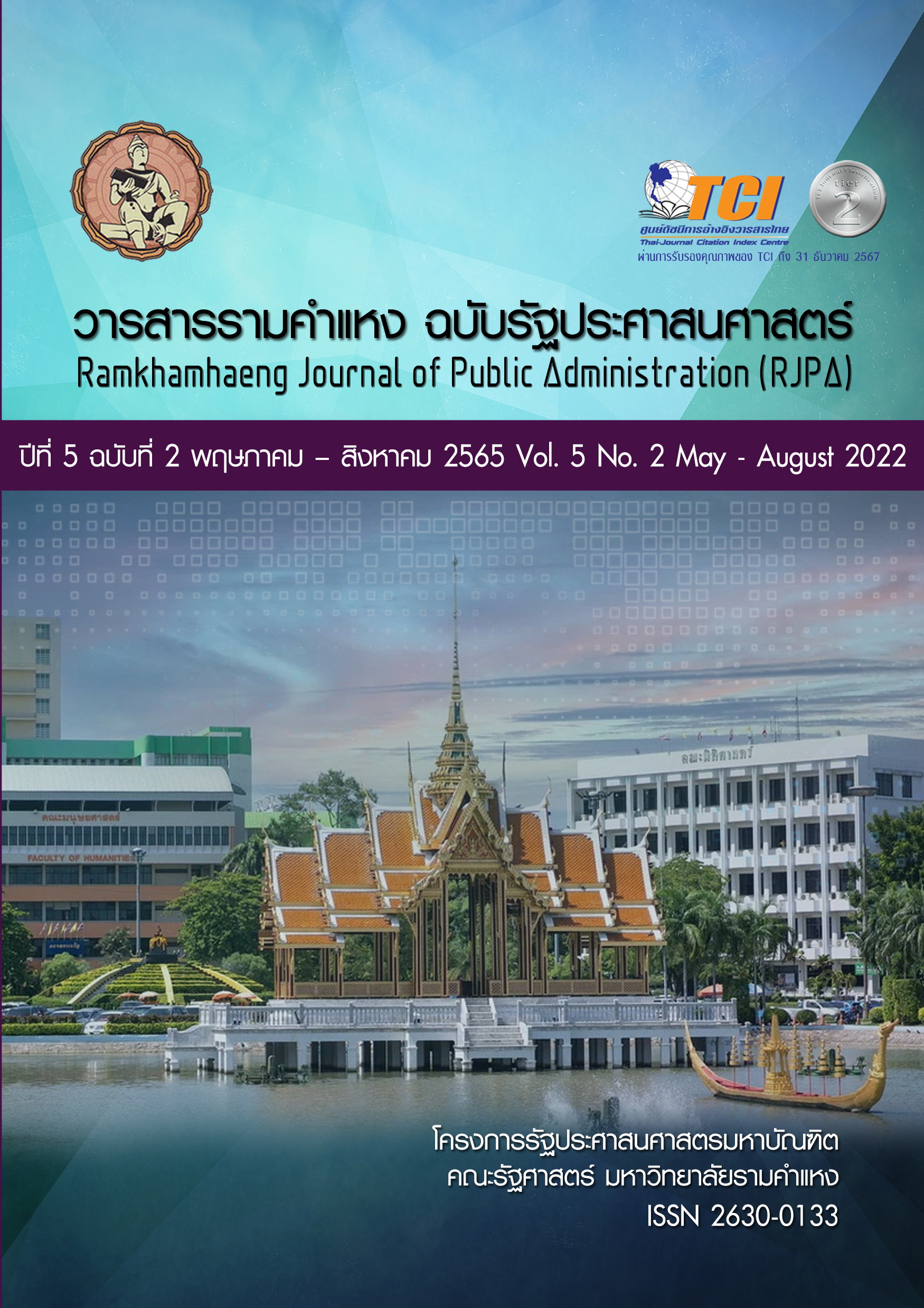บทบาทของการวิจัยตลาดสำหรับแนวคิดหลังการบริหารจัดการภาครัฐแนวใหม่
คำสำคัญ:
การวิจัยตลาดในองค์การภาครัฐ, การวิจัยตลาดสำหรับการบริหารจัดการภาครัฐ, การวิจัยการตลาดสำหรับแนวคิดหลังการบริหารจัดการภาครัฐแนวใหม่บทคัดย่อ
การปฏิรูปแนวคิดเกี่ยวกับการบริหารจัดการภาครัฐแนวใหม่ไปสู่แนวคิดยุคหลังการบริหารจัดการภาครัฐแนวใหม่ส่งผลต่อรูปแบบการบริหารจัดการภาครัฐที่มุ่งเน้นการร่วมคิดสร้างคุณค่าสาธารณะ การร่วมมือกัน การจัดการเครือข่าย ความสามารถในการตอบสนอง การมีส่วนร่วมของประชาชน ซึ่งการใช้ข้อมูลที่มีคุณภาพสำหรับการตัดสินใจเชิงนโยบายจากผู้ที่ได้รับผลกระทบในทุกภาคส่วนเป็นสิ่งจำเป็นสำหรับการตอบสนองต่อความต้องการของพลเมืองในสังคม การวิจัยตลาดเกี่ยวกับข้อมูลพฤติกรรม ความคิดเห็น ความต้องการของผู้ใช้บริการ ผู้ได้รับผลกระทบหรือพลเมือง นอกจากจะลดความเสี่ยงในการตัดสินใจเชิงนโยบายที่ผิดพลาด ยังสามารถสร้างความร่วมมือกันระหว่างองค์การภาครัฐและชุมชนในการกำหนดนโยบายสาธารณะที่มีการร่วมคิดสร้างสรรค์คุณค่าสาธารณะ การวิจัยตลาดถูกนำมาใช้ในการบริหารจัดการภาครัฐแนวใหม่มากขึ้น ตั้งแต่ช่วงแนวคิดการบริหารจัดการแนวใหม่ เห็นได้จากการสำรวจความพึงพอใจของประชาชนในด้านต่างๆ ซึ่งได้รับอิทธิพลมาจากกรอบแนวคิดการบริหารคุณภาพทั่วทั้งองค์การ ต่อมาในยุคแนวคิดหลังการบริหารจัดการภาครัฐแนวใหม่ การวิจัยตลาดได้เข้ามามีบทบาทมากขึ้นจากเดิมที่ถูกนำมาใช้หลังจากการนำนโยบายไปปฏิบัติ องค์การภาครัฐในหลายประเทศเริ่มนำการวิจัยตลาดมาใช้ตั้งแต่ช่วงกระบวนการก่อตัวนโยบาย อย่างไรก็ตาม ประสบการณ์ของนักรัฐประศาสนศาสตร์เกี่ยวกับการวิจัยตลาด และการยึดติดในแนวคิดการบริหารยุคการบริหารจัดการภาครัฐแนวเก่ายังคงเป็นประเด็นที่ท้าทายในการนำการวิจัยตลาดมาใช้ในการจัดการบริหารภาครัฐ ดังนั้น การพัฒนาหลักสูตรนักรัฐประศาสตร์ควรให้ความรู้เกี่ยวกับสาขาวิชาการวิจัยการตลาดเพื่อเตรียมความพร้อมในการทำงานในยุคหลังการบริหารจัดการภาครัฐแนวใหม่
เอกสารอ้างอิง
กรมส่งเสริมวัฒนธรรม. (2561). คู่มือดำเนินงานตามพระราชบัญญัติส่งเสริมและรักษามรดกภูมิปัญญาทางวัฒนธรรม พ.ศ. 2556. พิมพ์ครั้งที่ 2. กรุงเทพฯ : สำนักงานกิจการโรงพิมพ์องค์การสงเคราะห์ทหารผ่านศึก.
ณัฐพล ขันธไชย. (2558). Strengthening of the Executive Centre: Looking Beyond NPM as the Explanation of Change. KASEM BUNDIT JOURNAL, 16(1), 144-148.
ปกรณ์ ศิริประกอบ. (2559). 3 พาราไดม์ทางรัฐประศาสนศาสตร์: แนวคิด ทฤษฎี และการนำไปปฏิบัติจริง. พิมพ์ครั้งที่ 2. กรุงเทพฯ : โรงพิมพ์แห่งจุฬาลงกรณ์มหาวิทยาลัย
พงศกร ศรีรงค์ทอง. (2020). ความหลากหลายของแนวคิดการจัดการภาครัฐแนวใหม่กับแนวโน้มการจัดการภาครัฐในอนาคต. จันทรเกษมสาร, 26(1), 31-44.
อรุณี สัณฐิติวณิชย์. (2557). การร่วมกันจัดบริการสาธารณะระดับท้องถิ่นของพลเมือง: กรณีศึกษาการจัดการขยะของชุมชน ชลประทานจังหวัดอุบลราชธานี Citizens Co-Production in Local Public Service: The case of waste management of Cholpratan community, Ubon Ratchathani Province. Veridian E-Journal, Silpakorn University (Humanities, Social Sciences and arts), 7(1), 625-635.
Aaker, D. A., Kumar, V., Leone, R. P., & Day, G. S. (2013). Marketing research: International student version. New York: John Wiley & Sons.
Prentice, A. (1984). Research in public administration. Knoxville: The University of Tennessee.
Bălăşescu, M. (2019). METHODS OF OBTAINING THE INFORMATION NECESSARY TO UNDERLIE THE MARKETING POLICIES SPECIFIC TO PUBLIC INSTITUTIONS. Bulletin of the Transilvania University of Brasov. Economic Sciences. Series V, 12(1), 9-14.
Brabham, D. C. (2013). Using crowdsourcing in government (pp. 1-42). Washington, DC: IBM Center for the Business of Government.
Christensen, T. (2012). Global ideas and modern public sector reforms: A theoretical elaboration and empirical discussion of a neoinstitutional theory. The American Review of Public Administration, 42(6), 635-653.
Christensen, T., & Lægreid, P. (2007). The whole‐of‐government approach to public sector reform. Public administration review, 67(6), 1059-1066.
Çolak, Ç. D. (2019). Why the New Public Management is obsolete: An analysis in the context of the Post-New Public Management trends. Hrvatska i komparativna javna uprava: časopis za teoriju i praksu javne uprave, 19(4), 517-536.
Criado, J. I., Dias, T. F., Sano, H., Rojas-Martín, F., Silvan, A., & Filho, A. I. (2021). Public innovation and living labs in action: a comparative analysis in post-new public management contexts. International Journal of Public Administration, 44(6), 451-464.
Denhardt, R. B., & Denhardt, J. V. (2000). The new public service: Serving rather than steering. Public administration review, 60(6), 549-559.
Dyer, R. F., & Shimp, T. A. (1977). Enhancing the role of marketing research in public policy decision making. Journal of Marketing, 41(1), 63-67.
Grigorescu, A. (2006). Marketing of public and private affairs–a link. Kybernetes.
Halligan, J. (2010). Post-NPM responses to disaggregation through coordinating horizontally and integrating governance. In Governance of public sector organizations (pp. 235-254). Palgrave Macmillan, London.
Hodgkinson, I. R., Hughes, P., Hughes, M., & Glennon, R. (2017). Does ownership matter for service delivery value? An examination of citizens’ service satisfaction. Public management review, 19(8), 1206-1220.
Hood, C. (1991). A public management for all seasons?. Public administration, 69(1), 3-19.
Ingram, K., & Nitsenko, V. (2021). COMPARATIVE ANALYSIS OF PUBLIC MANAGEMENT MODELS. Scientific Bulletin of National Mining University, (4).
Kaplan, A. M., & Haenlein, M. (2009). The increasing importance of public marketing: Explanations, applications and limits of marketing within public administration. European Management Journal, 27(3), 197-212.
Kolltveit, K. (2015). Strengthening of the executive centre: Looking beyond NPM as the explanation for change. International review of administrative sciences, 81(1), 18-36.
León, L. R., Simmonds, P., & Roman, L. (2012). Trends and Challenges in Public Sector Innovation in Europe (Thematic Report 2012 under Specific Contract for the Integration of INNO Policy Trend Chart with ERAWATCH (2011–2012). Technopolis Group. Contract number xo7.[žiūrėta 2018-02-21]. Prieiga internete: https://www. technopolis-group. com/wp-content/uploads/2014/06/1447_INNOERATREND
-2011-12. pdf.
Lodge, M., & Gill, D. (2011). Toward a new era of administrative reform? The myth of post‐NPM in New Zealand. Governance, 24(1), 141-166.
Löffler, E. (2001, May). Defining quality in public administration. In Paper delivered at the Annual Conference of the Network of Institutes and Schools of Public Administration in Central and Eastern Europe (NISPAcee), Bratislava: NISPAcee.
Lourenço, R. P., Jorge, S., & Rolas, H. (2016). Towards a transparency ontology in the context of open government. Electronic Government, an International Journal, 12(4), 375-394.
Malikova, L. (2000). Formation of politico-administrative relations on local level in Slovakia. United Nations Online Network in Public Administration and Finana.
Mulgan, G. (2014). The radical’s dilemma: an overview of the practice and prospects of Social and Public Labs. P.4: ค้นเมื่อ 25 เมษายน 2565
https://media.nesta.org.uk/documents/social_and_public_labs_-_and_the_radicals_dilemma.pdf
Nunan, D., & Di Domenico, M. (2019). Rethinking the market research curriculum. International Journal of Market Research, 61(1), 22-32.
Petrescu, M. (2019). From marketing to public value: towards a theory of public service ecosystems. Public Management Review, 21(11), 1733-1752.
Reiter, R., & Klenk, T. (2019). The manifold meanings of ‘post-New Public Management’–a systematic literature review. International Review of Administrative Sciences, 85(1), 11-27.
Steen, T., Brandsen, T., & Verschuere, B. (2019). Public administration into the wild: Grappling with co-production and social innovation. in A research agenda for public administration. Edward Elgar Publishing.
Sorensen, E., & Torfing, J. (2012). Introduction: Collaborative innovation in the public sector. The Innovation Journal, 17(1), 1.
Teodorescu, B. (2001). Marketing politic şi electoral. Bucharest: Comunicare.
Wilkie, W. L., & Gardner, D. M. (1974). The Role of Marketing Research in Public Policy Decision Making. Journal of Marketing, 38(1), 38–47. https://doi.org/10.2307/1250165
ดาวน์โหลด
เผยแพร่แล้ว
รูปแบบการอ้างอิง
ฉบับ
ประเภทบทความ
หมวดหมู่
สัญญาอนุญาต
ลิขสิทธิ์ (c) 2025 ทัธภร ธนาวริทธิ์, บุญเกียรติ การะเวกพันธุ์

อนุญาตภายใต้เงื่อนไข Creative Commons Attribution-NonCommercial-NoDerivatives 4.0 International License.



